Text
Hey Jody!
I really enjoyed reading your blog post. I liked the quote you brought up from class. Instilling a love for nature in kids at a young age helps to preserve the future generations' relationship with the environment. If a genuine connection is made filled with empathy and appreciation, it can create a call to action. I completely agree, as corny as it is to say, the kids are the future, so if we teach conservation and sustainability practices from a young age, we're essentially investing in a greener, more cared-for future. I liked that you addressed the responsibility of a nature interpreter to tailor the content to the audience. Obviously, the content portrayed to children should be done differently than an adult. The use of storytelling with kids is super important! While working on the children's podcast, I found lots of research stating the importance of visual imagery in understanding concepts for children. As a nature interpreter, we have to ensure that the information being portrayed remains fun and intriguing for the child. Everyone learns differently, so incorporating aspects of every type of learner is important, whether that be visual, auditory, or kinesthetic. I liked the idea of guided hikes because, for me, this is one of the best ways to learn. The amount of new things that you can see while on a walk in the wilderness is crazy! The pictures you included provide further evidence of that haha. I liked how you even mentioned the more simple approaches to nature interpretation and education. I never would have thought that nature blogs would be so helpful, but after completing many throughout this course, I've learned so much new information from my peers. Your blog really made me reflect on my experiences, not only in this course but in my life as well!
Final Blog: Beliefs of a Nature Interpreter
Hey everyone, welcome back! This will be my final blog post and I just wanted to take a quick second to thank everyone for reading my thoughts and ideas and I wanted to say it was a wonderful time! I really enjoyed seeing all your opinions about my thoughts and I hope to see them one last time in this post! Stay strong, protect the natural world around you, and keep exploring! As always I hope you enjoy my thoughts and pictures.
Nature is such an important part of everyone's life, and must be preserved at all costs. However, to some nature is more than just an escape. It’s a calling. I believe that every little thing in nature is worth saving, protecting, and maintaining its beauty. In the class content it said, “we can create nature-rich communities where kids feel a deep and abiding love for the living systems that we are all immersed in” (Hooykaas, 2024), and this quote really stuck with me because I believe that every person in this world should be given the ability to establish their own special bond with the natural world around them. I believe the preservation of nature should be of the utmost importance because if the natural world changes too much there may not be any of the same things that we hold dear left to explore, and without it so many people would be left confused and unsure where to wander. I believe it is also extremely important to teach others, especially the younger generations how very important it is to maintain the beauty of what can occur when humans do not manipulate the environment. I also believe it is important to not interfere with natural occurrences that you might stumble across no matter how disturbing, awkward, or sad it may be. For example, last summer I came across many different animals doing various things from water snakes mating to a garter snake eating to a family of beavers building a damn under a dock, of course I tried to take pictures if I could, but not a chance would I get too close or startle the animals due to the slightest chance of it messing with their routine.
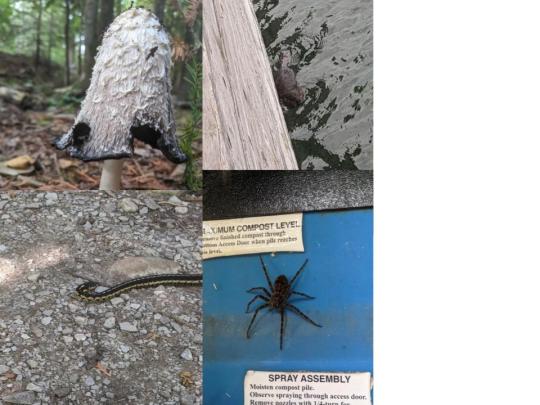
This is a collage of a few things I’ve witnessed while out exploring nature. Top left is a shaggy mane mushroom, top right is a member of the beaver family that was creating a dam, bottom left is a garter snake attempting to eat an earthworm, and the bottom right is a very large wolf spider that was just hanging around.
Being an nature interpreter is a role that must help others explore aspects of nature that they wouldn’t have thought to look at. Nature interpreting is so much more than simply a job. As I said before it’s a calling, a passion, a craving for exploration, and bringing what is unknown into the light for other people to be in the know. Nature interpreters have some of the largest responsibilities for the future. They hold the responsibility of being storytellers for future generations. They won’t just say facts about nature because that is not what gets people, more importantly kids, interested in the natural world. Kids are interested in video games and have simulations of nature, however, it is the responsibility of nature interpreters to tell exciting and eccentric stories that get them wanting and willing to go out and experience it for themselves (Boeckel, 2015). It is also the responsibility of the interpreter to be well-prepared, insightful, and communicate efficiently and in an appropriate manner depending on the audience that they are attending to. It is also the responsibility of the interpreter to, while telling the stories, make sure that everyone who is listening knows how important even the smallest thing in an ecosystem is all the way down to the small twig/branch the kids may want to pick up and play with.
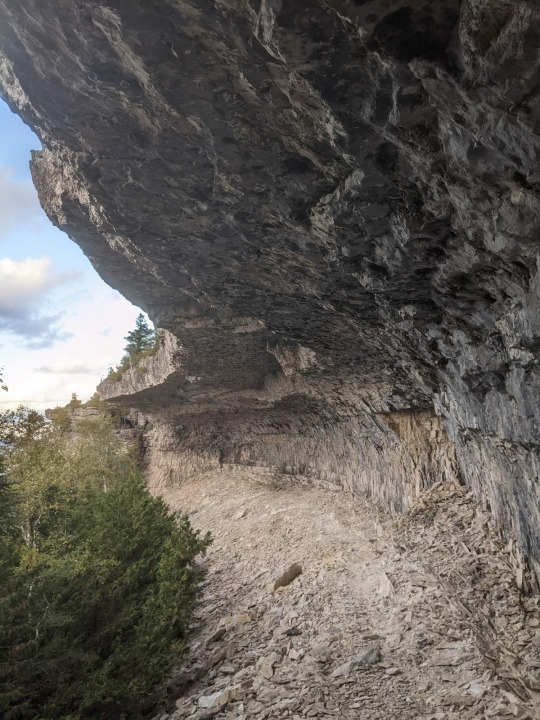
This was a location that we visited called Overhanging point (name is kinda self explanatory) during a guided hike. This was carved out by glacial ice movement.
As an individual it may seem difficult at times to think that what you say has an impact on the overall scheme of things, but there are many things that one person can do that can change and pull so many more people in. As it says in the textbook, find a way to articulate your ideas and points in a relevant, creative, and caring manner because that is what draws the attention of others (Beck, Cable, and Knudson, 2018). There are many ways to engage groups of people, and some effective ways are: holding interactive presentations for specific topics, creating a podcast that can appeal to younger and older audiences with many games such as guess the bird call, or guess that animal by the description, guided hikes are also a good tool to pique the interest of the more outdoorsy type of person, and sometimes even simple blogs like this one is an effective tool for getting ideas across to a very significant amount of different people. I know from personal experience that the two most effective ways to reach me with different information is an interactive presentation, or a guided hike. These two speak to me the most because I find them the most useful for engaging people. Guided hikes are a very nice way of exploring the wilderness because not only do you get to be out in nature, but you are able to hear the backstories of all the caves, rock formations, or anything that you may come across during the hike. However, each person has a different way of engaging with nature.
That’s all I have on my mind for now, and I hope everyone enjoyed my thoughts this time, and I hope you have all enjoyed my previous posts too! I had a wonderful time sharing my opinions and thoughts over the past months. I am looking forward to everyone's replies and ideas of their own.
Beck, L., Cable, T.T., and Knudson, D.M. (2018). Interpreting cultural and natural heritage: For a Better World. Sagamore Publishing.
Boeckel, J.v. (2015). At the heart of art and earth: an exploration of practices in arts-based environmental education. Envir. Edu. Research. 21 (5), 801-802. https://doi-org.subzero.lib.uoguelph.ca/10.1080/13504622.2014.959474
Hooykaas, A. (2024). Unit 10: Nature Interpretation’s Role in Environmental Sustainability. University of Guelph. https://courselink.uoguelph.ca/d2l/le/content/858004/viewContent/3640024/View.
12 notes
·
View notes
Text
Hey Michela!
Your post was really insightful! I love to see how different people interpret the content in the course and what specific aspects they hold to be significant. I agree that understanding the impact of human activity on nature is crucial in becoming a nature interpreter as it is our job to use nature as a call to action.
I'm also in the same forest biodiversity class and I really relate to what you said! Being able to learn about conservation education or rather the lack of education really helped to put our nature interpretation class into perspective. The role of nature interpreters is extremely important! The fact that many do not want to learn about certain environmental issues or educate themselves on sustainability if they do not have an “aesthetic” appeal really hurts my heart :( There are so many issues that ecosystems are facing and many just don't have the knowledge to help. This is where I think nature interpreters are really crucial. As the textbook stated, we need to find various other means to get the information across. I think it's important that we take the aesthetic aspect into consideration, but ensure that we are going beyond this artificial layer. We need to teach communities about the deeper, more profound importance of nature!
I love that you touched upon the aspect of empathy. I think Empathy is a very integral aspect as it allows us as nature interpreters to connect with our audience/peers on a deeper level. Empathy allows us to appreciate others' cultural viewpoints and background knowledge leading to a greater understanding of nature.
I like how you discussed humor as a way to teach. I know personally I would rather learn something that was light-hearted and humorous! I also touched upon real-life experiences as a personal ethic. In order for us to have a wide range of knowledge, sharing stories is essential. I specifically addressed Indigenous culture, as I believe their knowledge is super important in keeping our earth clean and thriving! We need to create more spaces that allow for open conversation without judgement and really just listen to what they have to say, as we are often the ones talking haha.
Overall I really liked your post and I agree on many of the aspects you touched upon. I also liked the videos and pictures you included. Super fun!
My Nature Interpretation Journey :)
As I grow as a nature interpreter, my personal philosophy is surrounded around creating a deep respect for the natural world and its intricacies. I believe that this should be extended to all kinds of life, as well as the various cultural viewpoints that influence our knowledge of nature. Conservation plays a crucial role in this philosophy. I see conservation not only as a means to protect and preserve the natural world but also as a way to come together as a collective and show respect for the world that has given us all so much. A large part of conservation is about acknowledging the impact of human actions on the environment and accepting responsibility for maintaining its future health.
As a nature interpreter, I aim to share these ideas with others, hopefully inspiring them to take action in their own lives to protect and conserve the natural environment that we all enjoy. I believe that by instilling a deep appreciation for nature and encouraging conservation initiatives, we can establish a more sustainable and harmonious relationship between humanity and the environment. A future where we are all educated and passionate about the earth is a great future.
In my Forest biodiversity class, we talk a lot about how a key reason why a lot of conservation practices aren't being done is due to the lack of education in the general public. For example, the media tends to always emphasize the negative effects of forest fires without also mentioning how beneficial they can be for promoting biodiversity and helping build its resilience. Another thing we talked about was Deadwood and how it is the basis for a lot of microhabitats. However, we have been destroying a lot of it due to the “unaesthetic” appearance of it. To me, this just further emphasized the need to ensure that, as an interpreter, I am using my platform to help educate individuals in a way that fosters a passion in them to want to advocate for such things.

As a nature interpreter, I also think that there are a lot of responsibilities that should be upheld in order to properly help others create deep connections to the natural world (Beck et al., 2018). This is because when sharing information with those who may lack it, you hold all the power, in the sense that you are providing them with a lens through which they will view and understand nature going forward (Beck et al., 2018). This responsibility requires a commitment to accuracy, empathy, and inspiration. By presenting information in a clear, persuasive, and friendly manner, interpreters can help promote a deeper awareness and understanding of the natural world, which can evoke a passion for the environment (Beck et al., 2018). This could even result in increased attitudes and behaviours toward conservation.
One key responsibility is to ensure you are respecting your audience's cultural perspectives and beliefs, as well as the culture of the specific area that is being discussed. As different cultures have their own unique relationships with nature, addressing interpretations from various viewpoints can make a big difference in helping others understand and relate to nature.
Another important responsibility is to give people room to form their own understandings of the natural world, regardless of how they may differ from your own. As an interpreter, your role is to guide and facilitate understanding, not to strictly impose your beliefs or interpretations onto others (Beck et al., 2018). A more nuanced and comprehensive understanding of the natural world can be achieved by promoting a conversation that is open and welcoming to all points of view and interpretations.
Over the course of this semester, I have learned that my approach as a nature interpreter is focused not just on memorizing facts and figures; but rather about engaging with the material in a way that has meaning to me as an individual. I've found that methods that include comedy and a less formal setting work really well. Incorporating humour has helped boost my enjoyment and retention of content while also allowing me to connect what I learn to my own life (Beck et al., 2018). The "informal-ness" of this approach allows me to really think about what I’m learning and how I can use real-life situations to deepen my understanding.
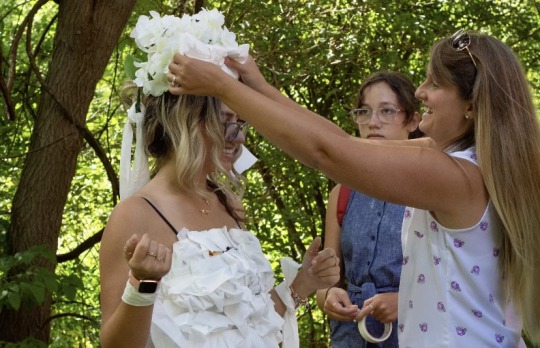
In addition to humour and a less strict atmosphere, I also value sharing real-life experiences in the learning process. Real-life experiences can provide valuable insights and perspectives that cannot be gained from textbooks alone. By sharing our experiences, we can learn from one another and gain a deeper understanding of the world around us (Beck et al., 2018). This goes hand-in-hand with another strategy I’ve come to like; encouraging open dialogue with my peers or audience. A discussion-based learning environment encourages active participation and thoughtful contributions from everyone. When this happens, and people talk to one another about a given topic, they share their unique thoughts and opinions, which helps everyone get a better grasp on the subject. This helps to encourage critical thinking. One way that I think discussion-based processes can be especially helpful is in conservation advocacy. Specifically, it can be a powerful way to develop stronger conservation frameworks that incorporate a greater range of perspectives and evidence.
Overall, a combination of these approaches not only makes learning more enjoyable for me, but also helps to create a welcoming learning environment for others!
References:
Beck, L., Cable, T.T., and Knudson, D.M. (2018). Interpreting cultural and natural heritage: For a Better World. Sagamore Publishing.
2 notes
·
View notes
Text
Final Blog: Personal Ethics as a Nature Interpreter
As I begin to write my final blog post, I find myself reflecting on all the new information I have learned over this semester. The content I learned in this course has not only changed my perspective on many aspects of nature but also helped me to realize the true importance of my role as a nature interpreter. Nature plays a role in everyone's life, and throughout this course, we have learned all the aspects in which it intersects, whether that be cultural, historical, or scientific.
In my journey as a nature interpreter, there are a couple of personal ethics that I would like to carry with me in the future, based not only on what this course has taught me but what I have learned in my own life experiences. With this, I look into myself and what I hold to be true. Having a foundation of kindness, open-mindedness, freedom of expression and a sense of responsibility and action are all qualities that are very important to me and were taken into great consideration when developing my ethics.
My first personal ethic to live by is of course my appreciation for nature. With the busy schedules people have, it can be hard to ‘stop and smell the roses’, and I find I have to often remind myself to take a breath and appreciate where I am. I try to go out for walks and to the arboretum to paint and draw as much as possible, not only to remind myself of nature's importance in my life but also to act as a sort of therapy for me. The sound of the leaves rustling, the shining light streaming down onto my sketchpad, a sense of relaxation washing over me. It reminds me that we both help each other, nature helping to calm my thoughts, while I try to advocate for a greater appreciation for nature. Appreciation is so important to me because if I lose my responsibility and sense of nature, how will I be able to help others?
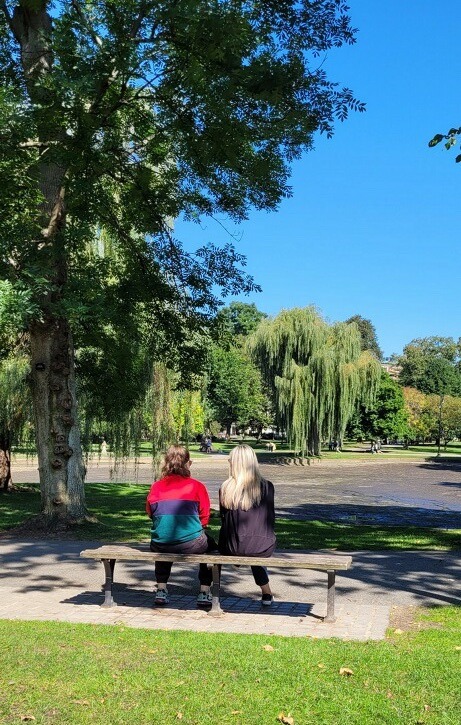
My mom and I taking in the nature in the Boston Common :) Unfortunately they were draining the pond when we visited
Another ethic that is important to me is the responsibility to educate and inspire others to appreciate nature around them. Throughout my life, especially in the past few years, I have noticed many people take nature and their surroundings for granted. I admit that I was one of them until I began my journey of nature education and haven't looked back since! I believe that my experience pushed me to want the same for others. Motivating my peers in terms of conservation and sustainability is something I hold close to my heart. We live in such a beautiful world that is currently experiencing so many negative effects at the hands of human activity, whether that be larger topics of discussion such as climate change, or smaller-scale issues like ignorance and refusal to learn. I constantly ask myself how we can reverse the damage we have caused, and I often come to the same answer; it all starts with a willingness and open-mindedness to become educated, and if that has to start with me, I am proud to take on the role! It is also important for me to understand and adjust to others' learning abilities. Many people are open to learning but have other barriers that have prevented them from doing so such as different learning approaches, or limited access to resources (Beck et al., 2018). Societal and cultural norms towards nature may also play a significant role in an individual's willingness to engage in conservation practices. Recognizing these barriers and altering how this information is portrayed is essential in being a great nature interpreter (Beck et al., 2018).
Before this course, I thought that spreading knowledge through nature interpretation might be a little limited in the way it could be done, however, my perspectives on this have changed. The variety of ways that we can present information is plentiful, whether it be through a storytelling approach (which is actually what I used on my first children's podcast!) or through humour and less formal concepts (Beck et al., 2018). I think working on my first podcast assignment helped me change my initial mindset and really allowed us to be playful, while still getting the overall message across. The content should be tailored to the individual, as they are the ones that need to absorb the information if we want to make a change and preserve our beautiful environment!
I am quite a visual learner, so it’s important for me as a nature interpreter to include visual aspects or imagery to help others as well. Many studies have actually been conducted on the impact visual imagery has on memory, with results showing that it helps to improve recollection and limit false memories (Oliver, Bays and Zarbrucky, 2016). By doing so, hopefully, it leaves lasting knowledge regarding nature, and motivates individuals to make a change and take care of our Earth.
Another personal ethic that I value is creating an inclusive, safe space where individuals can share their experiences and perspectives without fear of judgment. This became especially prevalent to me when we began to learn about the interconnectedness of nature and how people interact with it. I am currently taking a forest biodiversity class and we often address how different cultures, such as the Indigenous peoples look at and experience nature differently. It's fascinating and very important to explore various cultural perspectives, especially when these perspectives offer so many more insights and help us gain a deeper understanding (Beck et al., 2018). For example, Indigenous people place a high significance on what they call traditional ecological knowledge (TEK), representing the knowledge, practices, and beliefs regarding nature that they have accumulated over generations. As they are highly knowledgeable on the subject, creating a space for open conversations can help us to develop various new conservation efforts and sustainability practices.
Overall, there are many personal ethics that I have developed throughout this course. As I move forward in the future, I am sure my life experiences will help me to develop more, as I strive to become the best nature interpreter I can be!
I just wanted to say a quick thank you to everyone who read and responded to any of my blog posts! It has been such a fun experience interacting with all of you and learning more not only about myself, but my peers as well! Reading everyone's posts has definitely made me want to strive to become a better nature interpreter! I hope everyone enjoys and continues their journey with nature, hopefully educating other people along the way!
References:
Beck, L., Cable, T.T., and Knudson, D.M. (2018). Interpreting cultural and natural heritage: For a Better World. Sagamore Publishing.
Oliver, M.C., Bays, R.B., Zabrucky, K.m. (2016). False memories and the DRM paradigm: effects of imagery, list, and test type, The Journal of General Psychology, 143:1, 33-48, DOI: 10.1080/00221309.2015.1110558
0 notes
Text
Your blog post was a super fun and interesting read! Bioluminescence has always interested me and I learned quite a bit from your post. I appreciated the scene you described at the beginning of your blog. It made me want to go on vacation haha! My grandparents live in a very rural area, so since I was a kid we would go outside at night and observe and try to catch fireflies. I was familiar with these bioluminescent insects, however I didn't know there were so many other organisms that had bioluminescent properties as well. I was also particularly interested in the bioluminescent bays you discussed. It is now officially on my bucket list to see one of these bays in person! I always knew of the phenomenon of bioluminescence in the ocean but I never knew it was because of creatures called dinoflagellates. It's super cool that these tiny creatures are what causes such a drastic, beautiful change in the ocean when they sense movement. When I was reading your post about these creatures I couldn't help but think of the scene in Moana :)
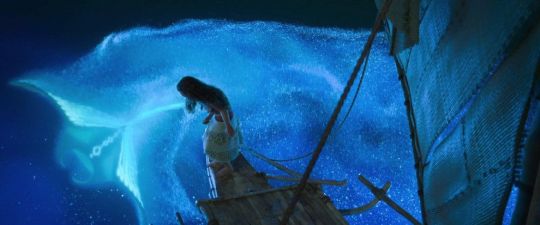
It's incredible to think about all the diverse ways these organisms use their bioluminescence to their advantage. It truly has so many functions, whether it be camouflage, communication, or some type of defense response. Your blog not only deepened my understanding of this process but also made me appreciate these creatures that I didn't know existed. I am also excited about new scientific advancements or discoveries regarding these types of organisms. I feel like there are still so many underlying mechanisms involved that we have yet to understand. It's intriguing to see how the discovery of new creatures helps to further illuminate our understanding!
The Most Amazing Thing About Nature
Welcome nature enthusiasts to my blog and prepare to be mesmerized!
Have you ever just opened up a travel brochure and seen beautiful pictures of islands with clear blue water or glowing beaches at night? Well, imagine this, a warm summer night with you standing right by the shore with your toes digging into the sand and waves gently rushing towards your feet. The moon is the only bright thing in sight, until suddenly the water starts to glow a bright blue, illuminating the darkness. What you are imagining isn’t a scene from a disney movie but one of nature’s most amazing displays.
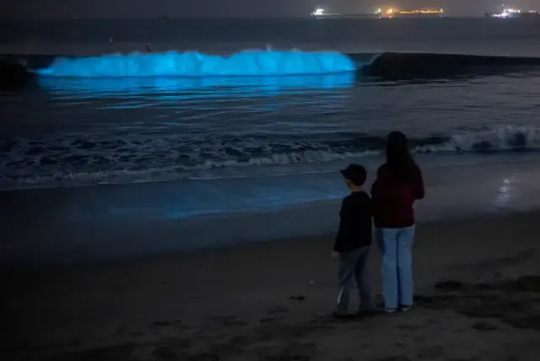
Bioluminescent waves spotted at Long Beach in California
(https://www.usatoday.com/story/news/nation/2024/01/04/bioluminescence-beach-waves-orange-county-california/72102677007/ )
Bioluminescence is one of the most mesmerizing phenomena nature has to offer. If this rings a bell or you’re not sure what it is let me backtrack and refresh your memory. Bioluminescence is when living organisms produce light (US Department of Commerce, 2010). Bioluminescent creatures exist in places like the deepest parts of the ocean to the dense woodlands. Each creature is unique in the way it emits light (US Department of Commerce, 2010). You’ve probably seen or noticed some of these organisms and never realized they are known to be bioluminescent like fireflies (US Department of Commerce, 2010)! One of the most iconic examples consist of marine organisms where an abundance of tiny dinoflagellates cause the ocean to glow, also known as bioluminescent bays.
When the dinoflagellates are disturbed or they sense movement, they respond by creating trails of light wherever they go (The Ocean Portal Team, 2023). Imagine canoeing through these waters at night (although I do not recommend it) while trailing your hand and watching as the water comes alive with shimmering light under your fingertips! It truly feels like a scene straight out of a fairytale. For example, bright waves traveling with the movement of dolphins spotted at Huntington and Newport beach in California. It’s not just the ocean but high in the treetops at the Kirstenbosch National Botanical Garden in South Africa where you’ll see enchanting fireflies. Or in depths of caves like the Waitomo Glowworm caves in New Zealand where the darkness is disrupted by the light from glowworms (Watkins et al., 2018). These insects found in dark and damp caves, emit a green light to attract prey or potential mates (Watkins et al., 2018).

An image of the caves in New Zealand lit up due to the glowworms
(https://www.nationalgeographic.co.uk/travel-and-adventure/2019/01/see-natures-amazing-glow-in-the-dark-spectacles)
Did you believe these organisms only light up to claim the title of the coolest creatures around? There’s more to it than meets the eye! Some bioluminescent organisms attract prey using their light like the glowworms (Watkins et al., 2018). Others use it to camouflage with their environment (The Ocean Portal Team, 2023). Most often it is used for communication like how fireflies flash their lights to attract mates (The Ocean Portal Team, 2023). Animals like jellyfish use their ability to defend themselves by scaring their predators (The Ocean Portal Team, 2023).
The magic of bioluminescence doesn’t stop there! Scientists are still discovering new species and finding out how and why these organisms produce light. From glowing fish to fireflies high up in the sky, there is a diverse variety of bioluminescence. So next time you look out into the ocean or gaze out at the night sky, think of all the glowing organisms. Hopefully, after reading today’s blog, I’ve gotten my message across and brought the experience directly to you!
The Ocean Portal Team. (2023a, May 11). Bioluminescence. Smithsonian Ocean. https://ocean.si.edu/ocean-life/fish/bioluminescence
US Department of Commerce, N. O. and A. A. (2010, February 12). What is bioluminescence?. NOAA’s National Ocean Service. https://oceanservice.noaa.gov/facts/biolum.html#:~:text=Bioluminescence%20is%20the%20production%20and,surface%20to%20the%20deep%20seafloor.
Watkins, O. C., Sharpe, M. L., Perry, N. B., & Krause, K. L. (2018). New Zealand glowworm (arachnocampa luminosa) bioluminescence is produced by a firefly-like luciferase but an entirely new luciferin. Scientific Reports, 8(1). https://doi.org/10.1038/s41598-018-21298-w
4 notes
·
View notes
Text
Painting the Sky: The Beauty of the Northern Lights
Welcome back to my blog! This week I was so excited when I read the prompt as there are so many amazing things that excite me about nature. After taking some time to think I settled upon the phenomenon of the northern lights or aurora borealis!
Since I was a little kid, I have always been so fascinated with the northern lights, and it has always been something that my family and I would talk about going to see. As a young girl, my dad would constantly tell me and my sister stories of his childhood where he grew up in Deep River, Ontario. The northern lights are very common there, and he would often see them. Since then, this has become one of the top things on my bucket list. To be able to experience this beautiful aspect of nature with my family is something that I am excited to do! Luckily, we are starting to plan a trip to Deep River to go visit old friends and see where my dad grew up and of course, witness how these beautiful colours can paint the sky!
The Aurora is initially created by the sun, specifically from the charged particles on the sun's surface which create solar winds (Bourdreau et al., 2023). These particles travel far through the cosmos and occasionally interact with the Earth's magnetic field in a region called the ionosphere (Bourdreau et al., 2023). In this sphere, the solar winds will interact with various particles like nitrogen and oxygen, creating the bright stripes of colour that glow and light up the sky (Bourdreau et al., 2023). As a science major, I find this information super interesting and wanted to share it. Almost everyone knows what the Northern Lights are but I feel like many don't know how they actually came to be.

I have conducted much research on this topic, specifically looking at how this natural phenomenon affects people and culture. One of my favorite aspects about this natural wonder is how people connect and interpret it. Scientists have been able to figure out how the northern lights occur, which I briefly explained above, however for me, sometimes the cultural explanations can be even more intriguing and beautiful. For many Indigenous communities that inhabit areas of Canada where these lights are commonly visible, they are represented in their spiritual, oral, and cultural traditions. In their eyes, the lights represent manifestations of spirits or their ancestors as they dance across the sky, telling tales of creation and existence (Fikowski, 2021). Similarly, the Inuit tribes believed that they could converse with their dead relatives and ancestors through the magic of the lights (Hurtigruten Group, 2023). Scandinavian folklore shares some similarities with the Indigenous peoples, however they also have their own take on the lights. The northern lights are thought to be the works of the supernatural, with some legends stating they represent pathways for gods to travel between their world and our mortal world (Hurtigruten Group, 2023). Some legends state that these lights represent something more evil, telling stories of the dangers they possess (Hurtigruten Group, 2023). It's so interesting how one aspect of nature can be interpreted so differently worldwide. To me, this is such a major aspect of nature interpretation. Being able to share your beliefs and stories with others offers new perspectives and strengthens the bonds people have not only with each other but with nature as well. By looking at these legends and belief systems we can learn many valuable lessons about the interconnectedness between the natural world and preservation of cultural heritage to be passed down to future generations (Beck et al., 2018).
The next time you think of the Northern Lights or are lucky enough to have seen it, I want you to keep this in mind, and take a moment to reflect on the rich cultural traditions that are associated with this wonder. I really hope I get to see the Aurora Borealis with my own eyes soon!
References:
Beck, L., Cable, T. T., & Knudson, D. M. (2018). Interpreting Cultural and Natural Heritage: For A Better World. Sagamore Publishing.
Boudreau, D., Turgeon, A., Sprout , E., & McDaniel, M. (2023). Aurora. National Geographic.
Fikowski, T. (2021). “those are our ancestors in the sky:” sacred beliefs about the Northern Lights. CTV News: Calgary. https://calgary.ctvnews.ca/those-are-our-ancestors-in-the-sky-sacred-beliefs-about-the-northern-lights-1.5661211
Hurtigruten Group. (2023). History of the Northern Lights: Myths and legends. Hurtigruten.
Seedokmai, C. (2024). Northern lights appear as ribbons of green and purple light streaking across the sky and reflected in the water below. https://cdn.mos.cms.futurecdn.net/k6okX2VVUg4qWoyxuNLsf7-1200-80.jpg.webp
0 notes
Text
Hey Michela,
I enjoyed reading your discussion post! I liked the way you outlined the relationship between music and nature as it is a very complex topic. I enjoyed the imagery you brought to your post as it really helped me to understand your points and to use my own memories to establish a clear connection between nature and its sounds. For me, I like to think that the chirps of birds, the slight breeze of the wind or even the sound of a squirrel or chipmunk are all part of an orchestra that creates the symphony of nature! I also liked how you brought up the association of memories and nature, as this is also something I briefly addressed in my post, and find it quite fascinating. While doing some research I found that we as human beings are naturally drawn to nature, whether that be photographs, landscapes, or sounds. I believe music is super important for nature interpreters to utilize as they often create positive memories with the different aspects of nature. For example, I know there are still songs I listen to that immediately take me back to my trip to Mexico in 2010 that I associate with the palm trees and beautiful sunsets. One of these songs is called 'When the Night Feels my Song' by Bedouin Soundclash, I recommend giving it a listen if you haven't!
It's really cool how connected music is, to the point where it can cause people to reminisce about nature they experienced, in my case, over a decade ago! I also loved the song you chose haha! Although it doesn't have any special connections to nature for me, it's fun to hear how other people’s experiences differ. I've actually never seen the Sisterhood of the Traveling Pants but based on your experiences I might have to give it a watch. Overall you had a really great post!
Music <3
Hi again everyone,
This week’s prompt is so simple yet has left me stumped as I try to effectively gather my thoughts and form my opinion. It’s hard to articulate. I think this is because music can have such a strong effect on our thoughts and emotions, it's not exactly logical - more of a feeling I guess. This brings me to my point. I think that nature and music have this incredible connection where they blend perfectly. For example, imagine being in a sunny wooded path. Now picture listening to the natural sounds of a bird song and the wind in the trees. This just feels right to me. It makes the whole imaginary situation seem more real.
Certain songs can also just ‘fit’ with memories of nature. For example, a specific song might remind you of a beautiful sunset you once watched, or a peaceful moment by a lake. It's like the music and the memory of nature become intertwined, enhancing each other while also making the experience more vivid.
I think this connection between music and nature is so powerful because they both speak to something deep inside us. It's difficult to describe, yet they both have the ability to evoke feelings and memories. It's as if they reach a part of our minds that is inconceivable and allow us to simply feel. I think this is why I’ve struggled so much to explain the relationship of nature and music.
But it's not just about memories. Music can also change how we see nature. Imagine a gentle, calming tune. Don't you think this would be effective at amplifying the tranquillity of a bright sunny scenery? Or what about a high-spirited song? This could make a crowded city park feel more vibrant and alive. Now obviously if you were walking down a dark and scary path in a creaking forest, soft upbeat music wouldn't help - it actually might make it scarier, but in general, I think music can amplify our emotions in nature. This goes hand-in-hand with what we learned this week, reflecting how music can influence nature interpretation (Beck et al. 2018). And vice-versa!
When trying to think of a song that immediately brings me back to a natural landscape, the only song I can think of is “Unwritten” by Natasha Bedingfield. I know what you're thinking - this is not the typical song that reminds most of nature, but I think you’ll get it once I explain. When I hear this song I first think of the Sisterhood of the Traveling Pants movie, specifically the scene where Blake Lively is running on the beach listening to this. Then I think of a beautiful beach I once visited when I was younger in Latvija. It brings me such happy and peaceful emotions. The feeling of being free - from worries, from burdens, from everything.
Here's the OG music video:
youtube
I tried to add a clip of the scene from the movie but it wouldn't work. So here's the link if anyone's interested: https://www.dailymotion.com/video/xqrrcm
Does anyone else have a more unconventional song that brings them back to nature?
Beck, L., Cable, T. T., & Knudson, D. M. (2018). Interpreting cultural and natural heritage: for a better world. Sagamore Venture.
4 notes
·
View notes
Text
The Interplay Between Nature and Music
I was very excited when I read this week's blog prompt as music and nature are both something I am very passionate about, so getting to explore the relationship between the two was very intriguing! Music is present everywhere in nature, obviously not as full songs but as a variety of noises that mesh together to create a symphony of sounds. One of my favourite things to do when I am on a hike or just present in nature is to stop and take in my surroundings, trying to pinpoint every sound I can make out and maybe figure out where it is coming from.
My favorite season is fall, and besides Halloween and the fun festivities that come along with it, the main reason is because of the weather and changing trees. The sound of the rustling leaves creates a natural percussion that accompanies the brilliant colours as they fall from their branches. When in harmony with the wind it adds another layer and I can't help but feel as though I am caught in nature's rhythm. Some of my most peaceful moments have been sitting on a bench in the arboretum during the fall because of this.
I like to think that birds play a big role in creating music in nature. As I have mentioned previously, I love birds and even have some of my own. Their chirps create beautiful melodies that contribute to the overall soundtrack of nature. Even observing my own birds chirp happily when I bring them outside for a bit is music to my ears! The textbook states that interpreters should always find different ways to discuss nature and help others to relate to it, going beyond the conventional means (Beck et al., 2018). Music is a great way to do so as everyone can connect to music in one capacity or another. Music has been found to increase the dopamine in the brain so it is a universal tool that can help to form deeper connections with nature, or even increase one's empathy to certain environmental issues (Clarke et al., 2015).
Artists often take inspiration from the nature around them in their music. Listening to the steady flow of a stream, or the chirp of a bird could inspire them to create a specific song. Musicians will also often use nature sounds directly in their song to help portray a certain tone or emotion. For example, in the song Pink + White by Frank Ocean, you can hear faint wind and birds chirping throughout the whole song, with it especially prominent at the end. For me, these sounds make me feel nostalgic and remind me of memories of going to the fields and watching the sunsets in the summer with my friends. Often people have positive associations with these types of natural sounds and artists use this to their advantage, as humans have scientifically always gravitated towards natural images and sounds (Rogers, 2023).
youtube
If you haven't heard it yet, I suggest you take a listen to Pink + White, it is one of my favourite songs! P.S if you cant hear the birds throughout the song, you can go to the end at 2:53 to really hear them!
Besides Pink + White, it was very hard for me to think of one song in particular that takes me back to a specific memory of nature. However, one album that always transports me back to the landscapes I experienced is Flowerboy by Tyler the Creator. Throughout this whole album, he references nature many times, as you can see by the album cover below.
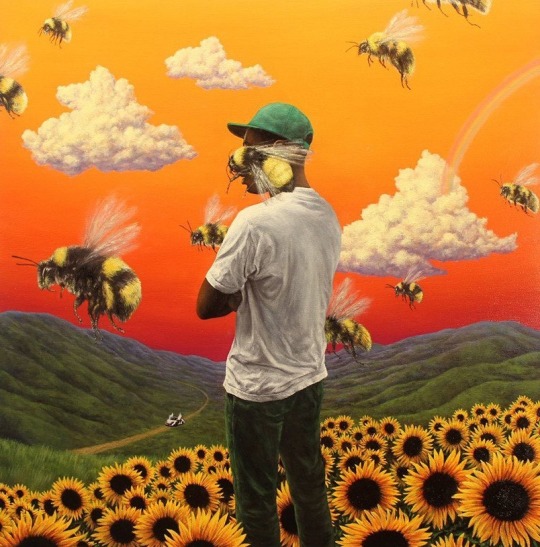
This whole album reminds me of the many times my friends and I would sit by Guelph Lake and watch the sunsets, as this was often playing on our speakers. I also went on a recent trip to LA for a music festival and was able to hear some of these songs live. While I was there, we visited the beach and went on many hikes up the mountains and I got to experience a completely different type of nature I had never seen before. So now I will always have these fond memories of nature when I hear this album!
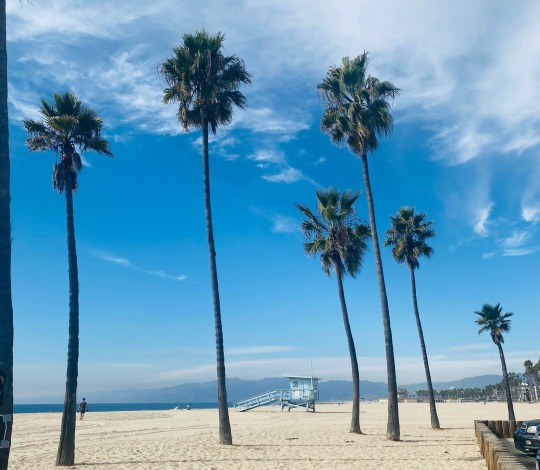
Here’s a quick photo I took while on a walk at Venice Beach!
Beck, L., Cable, T. T., & Knudson, D. M. (2018). Interpreting cultural and natural heritage: for a better world. Sagamore Venture.
Clarke, E., DeNora, T., Vuoskoski, J. (2015). Music, empathy and cultural understanding. Physics of Life Reviews. 15(1571-0645), 61-88
Rogers, K. (2023, June 13). biophilia hypothesis. Encyclopedia Britannica. https://www.britannica.com/science/biophilia-hypothesis
0 notes
Text
Hey Katya
I enjoyed reading your blog post this week! I agree with your interpretation of the quote, and I too believe that the connection between the past and present, specifically the integrity of this connection is so important. I liked that you used the concept of art to help unpack this quote as it really interested me. It allowed me to make sense of the quote using my own experiences as I have always admired art. As you said, with art, it's not just about who painted it and at what time, but rather the story it tells and the thoughts/memories it provokes. I loved the example of Starry Night you provided as it is one of my favorite pieces. It's crazy how a painting can have so much meaning and history associated with it. I always enjoy discussing this piece because everyone always has a different interpretation.
I enjoyed trying to decipher the train analogy in the quote and I think you did a good job at explaining the significance of it. For me, it helped to find examples that I could apply to the analogy, to explain its meaning. I looked at it from the perspective of the Aboriginal Peoples, as oral tradition and interconnectivity between the past and present are very important in their culture. The train continues on the tracks as it stops at each station, gaining new knowledge at each stop that contributes to the overall journey of the train. Intrinsic merit of integrity is crucial in cultural preservation and identity, especially within Aboriginal culture.
The quote you included, “History makes space meaningful” really resonated with me. History shapes an individual's perspectives but also helps to ground the connections made to the spaces being occupied. This historical context is necessary as it provides meaning to these spaces, and without it, there would be no connection between the past and present and we would be lost.
Overall great post!
Nature Interpretation Through History
I think one way I interpret this quote is that it is a perspective that highlights the importance of maintaining the integrity of the connection between the past and how it has shaped the future. Many times people will go to art exhibits or museums and automatically think about how old an artifact is and thus put a certain amount of significant value on the piece, myself included. It goes way beyond the age of the artifact. When we observe these pieces with a theoretical approach, we can dive deeper and discover that the significance of the artifact doesn’t just come from age but the story it's trying to tell. The meaning behind the pieces and the way in which they inspire individuals, encourage thought-provoking thoughts, and tell stories (Beck et al. 2018). For example, I am sure we all know the famous ‘Starry Night’ painting. Besides the fact that the painting is 135 years old and in perfect condition, it is a painting that portrays optimism and hope (Murrell, 2023). This painting is also associated with Van Gogh's deteriorating mental health and it is said that the blues he used correlate to the blues in previous paintings made during times of extreme mental health struggles (Murrell, 2023). When we view this piece in this approach, the direction of the importance behind this piece changes. It becomes a story, something you can relate to, something familiar. Others suggest that the contrast between the dark sky and yellow lights exemplifies the idea that although it's dark, as long as the stars are shining, there is always a light to guide you (Mayfield City School). Both interpretations are beautiful and surpass the value of the piece associated with its age.
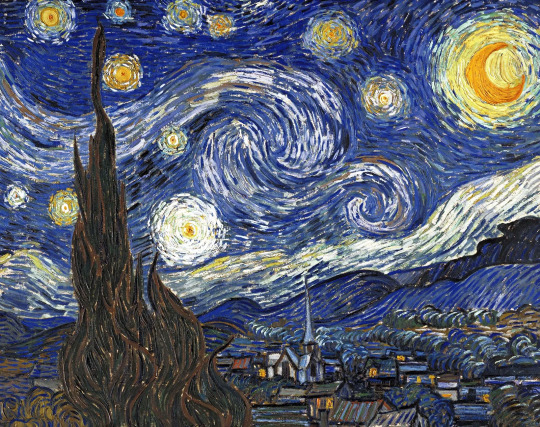
Starry Night By Vincent Van Gogh 1889 From: https://www.britannica.com/topic/The-Starry-Night
I think another prominent perspective is the idea that although something has already occurred, we simply cannot ignore the past. We hear all the time the past is in the past and that you can’t change the past which is true. However, the idea that the railway only existed for the length of time the train was there is an analogy to explain that although we are in the present and have moved on from the past, it doesn't mean the history of the past no longer exists. The present exists today because of the actions of the past. If we cannot learn to accept the connection of how the past shapes the future, we can lose sight of its significance. The teachings, lessons, and significance of history help us comprehend the past and how everything has evolved. History can provide us with a sense of community. We can become closer to each other intellectually through the recognition of memories, stories, and shared local traditions (Hooykaas, 2024). “History makes spaces meaningful” is such a powerful quote that I think explains the connection to one another as human beings through shared experiences (Hooykaas, 2024). One thing we all have in common is that we all have a past, although certain experiences are different, there are some shared experiences of the past by many of us. I believe this to be a connection between one another that cannot be ignored. This is how I interpreted the quote. Let me know what you all think!
Beck, L., Cable, T. T., & Knudson, D. M. (2018). Interpreting cultural and natural heritage: For A Better World. SAGAMORE Publishing
D., Murrell. (2023) https://study.com/academy/lesson/van-goghs-starry-night-description-analysis-facts.html#:~:text=The%20Starry%20Night%20meaning%20is,also%20indicate%20his%20mental%20state.
Hooykaas, A (2024) Unit 4: Nature Interpretation Through Art and Planning for "All" Scenarios. ENVS*3000. University of Guelph
Mayfield City School. (n,d) https://www.mayfieldschools.org/StarryNight.aspx#:~:text=There%20are%20various%20interpretations%20of,always%20light%20to%20guide%20you.
Painting:
1 note
·
View note
Text
Merit in Integrity: The Interconnectivity of Past and Present
For this week's blog post, I initially had trouble interpreting this quote as it seemed quite daunting, however as I reread it, I was able to understand the overall message. The beginning of the quote stated “There is no peculiar merit in ancient things, but there is merit in integrity” which struck a chord, and I found it to be quite profound. In my eyes, this statement is referring to the relationship that we have with the past. Recognizing and appreciating ‘ancient things’ or history is not just based on nostalgia but is necessary to move forward as a collective society. This quote specifically addresses the idea of interconnectivity between the past and present, paying close attention to the inherent value of maintaining one's integrity. One great example that helped me to unpack this is the concept of family recipes. For example, your grandma may have a famous recipe book that has been in the family for generations. The age of these recipes is not what makes them important or special; rather it's the memories, stories, and joy behind each recipe. This cookbook has now become a symbol of intergenerational connectedness as it preserves both the authenticity and integrity of previous generations. When recalling important aspects of our history, many people place importance on how old something is, as if its merit relies solely on this, often like a painting or piece of art. Many aspects of history need to be passed on to the future, not just age but traditions, values, and memories.
This quote got me thinking about the rich history throughout various cultures, and how these stories are passed along. In my other classes, I have recently learned more about Aboriginal People and I feel as though this quote can be directly related to their culture and values. Aboriginal People place a lot of value on history and oral tradition, connecting past and present memory (Augustine, 2009). The idea that there is no peculiar merit in ancient things but there is with integrity aligns directly with the core of the Aboriginal culture. Their various cultural practices and Dreamtime stories, which outline the story of events of how the universe and everyone in it came to be, provide a holistic view of the world, which coincides directly with the quote from Hyams.
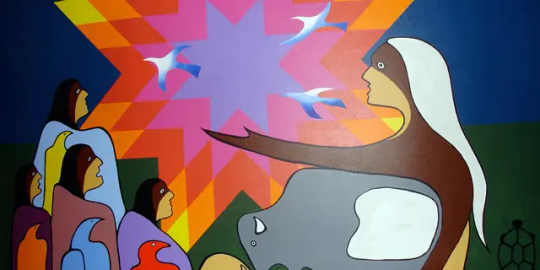
This painting by artist Dale Stonechild recalls his experiences of the stories told to him by his grandmother and other elders (Stonechild, 2014).
Unpacking the end portion of this quote, I liked the train analogy and believe it can be interpreted better through the lens of the Aboriginal Peoples. For them, their heritage and traditions are not finite but rather continuous, much like a train moving along its tracks and through stations. If people perceived their past as concluded, as the quote states, it would eliminate the significance of their cultural train, preventing the ongoing journey of knowledge and appreciation of the world. Each station the train stops at represents a memory or moment in time that contributes to the overall journey and integrity of the train or in terms of real life, one’s cultural identity.
This quote outlines the importance of the intrinsic merit of integrity over the age of history, representing the interconnectedness of the past and present. I believe this quote is especially significant in the Aboriginal culture, recognizing the ongoing cultural journey that allows for the preservation of integrity which defines who they are and what they believe.
Augustine, S. J. (2009). Oral traditions. indigenousfoundations. https://indigenousfoundations.arts.ubc.ca/oral_traditions/#:~:text=Oral%20traditions%20form%20the%20foundation,past%20and%20present%20in%20memory.%E2%80%9D
Beck, L., Cable, T. T., & Knudson, D. M. (2018). Interpreting Cultural and Natural Heritage: For A Better World. Sagamore Publishing.
Stonechild, D. (2014). Storyteller. 11 THINGS YOU SHOULD KNOW ABOUT INDIGENOUS ORAL TRADITIONS. Retrieved from https://www.ictinc.ca/blog/11-things-you-should-know-about-aboriginal-oral-traditions
0 notes
Text
Hey Denise!
I really enjoyed reading your blog post this week. I like how you went with a more informative approach. Although I too enjoy the warmer weather, especially when I have to walk to the other side of campus to get to class, it does scare me how drastic the weather changes are becoming. I also took climate change biology (ENVS*3010) a few semesters ago and it has really opened my eyes to the issues that surround growing climate change. Specifically, in the past 2023 year wildfires were a big concern of mine. Although climate change wasn't the sole cause of the wildfires in Canada, the Government of Canada did state that climate change played a role in increasing its intensity by 2x (Government of Canada, 2023). They also found that weather conditions that favor the creation of wildfires were 50% more intense due to climate change (Government of Canada, 2023). It's important that more people become aware of the consequences that climate change will have and is already having on our environment. The more we leave these issues untreated, the worse they will become. I really liked the questions you posed because I didn't really think about how our green winter would affect mating and proper development of plants. If plants or grasses start to develop earlier, they will be under more stress when the weather becomes cold again, which will inevitably happen in early winter months like February. I was very interested in this question so I conducted some more research and found that this could also cause grasses and other plants to remove important nutrients from the soil that will then no longer be present when the proper time comes for these plants to begin development. Overall, climate change is a very serious topic and I loved that your discussion post helped to bring these issues forward!
Government of Canada (2023). Canada’s record-breaking wildfires in 2023: A fiery wake-up call. Natural Resources Canada. https://natural-resources.canada.ca/simply-science/canadas-record-breaking-wildfires-2023-fiery-wake-call/25303
Warmer Winters Ahead
This week, we’ve experienced some fantastic weather in the Guelph area, and it has been enjoyed by many. The sun has been out, there are no buckets of snow being dumped on us, the birds are chirping, and even some bugs are reappearing. Personally, I enjoy being able to open up the windows in my apartment to air everything out, letting the fresh air in without turning the space into a walk-in freezer. It feels as if we are already deep into April given the weather being so springlike, however we aren’t even halfway into February. Normally, I would be the biggest supporter of warm weather, as snow is not my biggest fan, nor am I a fan of it. However, between this class ENVS*3000 (Nature Interpretation), and a course I took last term ENVS*3010 (Climate Change Biology), it has impacted my way of thinking dramatically, and I am growing more concerned about the world around us and how nature will change due to the effects of climate change.
In 2023, it was determined we would experience El Nino, which brings forth warmer, wet weather that could also bring more extreme weather patterns with it (ICL 2023). Its opposite, La Nina, does not commonly impact this part of North America, however the two tend to swing back and forth (ICL 2023). Together, they interrupt the natural atmospheric weather patterns and seem to only become more aggressive as the effects of climate change continue to grow more apparent (ICL 2023).
While all these changes in weather and temperature are explainable through science, the impacts it will have on our environment are still unknown, which makes me very fearful of what our natural spaces will look like in the future. For us to have such a green winter this year, it makes one curious about how this will impact the health and survival of all of those found within our green spaces. How does this type of weather disrupt their mating season? Will the species of plants still blossom and sprout when needed? Would they be able to survive the cold fronts that unexpectedly appear?
While this seems like an odd thing to think about, I am concerned about what nature will look like in just 10 or 20 years from now. What native species will no longer be able to live here? What will the forests look like years from now if events such as drought or wildfires become the new normal? Will we still have winters with the buckets of snow that we all loved as kids? As aspiring nature interpreters, I think it is our due diligence to be asking the big questions about the nature we find around us. I think it is important to live in the present, and enjoy what we have, but also look to the future and protect the environment for generations of nature interpreters to come.
[ICL] Imperial College London. (2023). What is El Niño and how is it influenced by climate change? Accessed February 10, 2024. .https://www.imperial.ac.uk/grantham/publications/climate-change-faqs/what-is-el-nino/
9 notes
·
View notes
Text
Blog 5: Free Write - Camping & Nature
As there was no prompt for this week's blog, I decided to look back on my life experiences and talk about one tradition my family does every summer that has brought us all closer to nature, and that's our annual camping trip. Every year my family and some of my extended family take a trip down to the Bruce Peninsula, specifically the Pinery Provincial Park. This is a tradition we have been doing for the past 8 years and I have enjoyed every single one of them! I always look forward to this trip as I often get caught up in school and work and have little time to enjoy or appreciate the nature around me, but being surrounded by trees with just a tent and a campfire offers a nice break. When we initially started our trips, we would pack quite heavy and bring a lot of supplies, even bringing an air mattress and electric fan the first year haha. However, as we continued, we realized that it would be more enjoyable if we were not bringing all these gadgets that we would have access to at home. For me it largely took away from the experience of being immersed fully in nature. 8 years later, we now try to bring as little as possible, shifting our campsite from very cluttered to much simpler, improving our experience so much!
I wanted to discuss this for my blog post as I think many people have trouble with the distractions of modern life/technology. Cutting out the extra baggage can be really hard at first but when it's just me, my sketchbook, and the sound of the leaves rustling in the trees, I've never been more at peace. I encourage everyone to grab some friends, and family or even go alone and reconnect with nature through its simplicity.
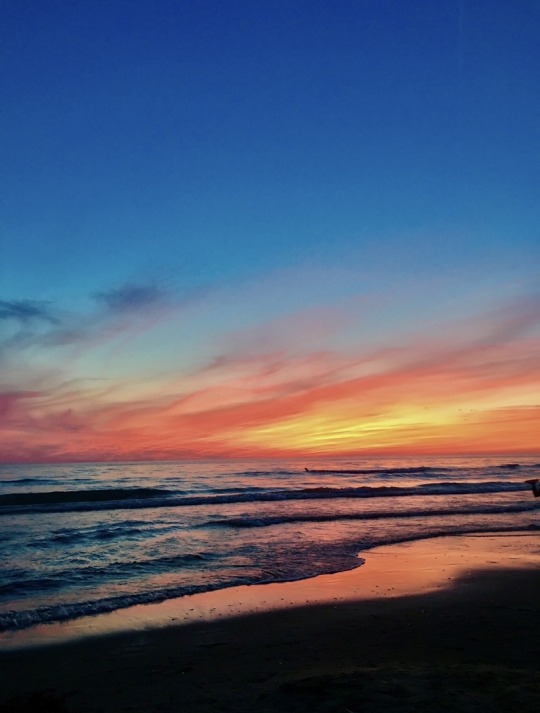
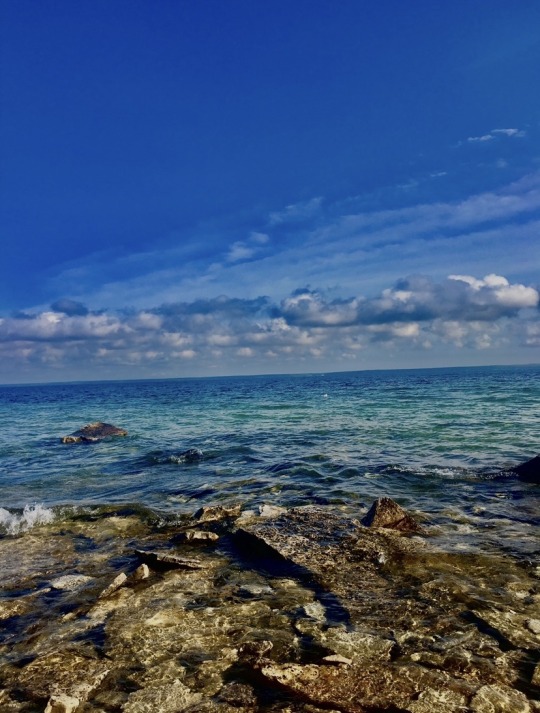
Here are a couple photos I took from my camping trips over the years :)
As I've mentioned previously I really enjoy being creative and expressing myself through art, so these camping trips are where some of my most creative ideas and visions have been created! Furthermore, they have some of the most beautiful trails throughout the forest and along the beach, some requiring hours to complete. This is one of my favorite things to do with my mom and we bond over it every year, which makes me even more appreciative of nature. My mom, my sister, and I have become quite interested in completing the end-to-end hike where you cover the entire 900 km Bruce Trail on foot over a couple of months. This would be such a cool experience to see the different landscapes all across the Bruce Peninsula and just an overall great accomplishment to have! If any of you have completed it or even did parts of the trail let me know as it would be really cool to discuss it!
I believe everyone should experience camping at least once in their life as it offers a whole new perspective on our relationship with nature. It helps you to not only discover new things about the world around you but also to discover new things within yourself. These trips played a big role in my interest in nature and pursuing environmental science courses at university!
1 note
·
View note
Text
Hey there,
I enjoyed reading your post! I loved that you touched upon the uniqueness behind experiencing art because this is so important for people to understand. Not everyone will share the same memories and insights that arise when interpreting art and we need to embrace this, sharing our own personal experiences to help broaden others' thoughts. I completely agree that culture can have a major impact on nature interpretations. I read a study regarding this and found it to be quite intriguing. Landscape art was actually heavily involved in the creation of various cultural identities around the world, helping to establish a sense of belonging (Wen and White, 2020), which is so cool!
Your Rome trip seemed to be very informative, and I loved the information you provided about Trajan’s Column. Like you said, when I think of Rome I think mainly of the Colosseum, so it was very interesting to learn something new! The story told in that artwork is incredible and really shows how art is perceived differently. Many people can look at that column and try to decipher what it means, however only the original artist will truly know, all we can do is interpret it using our own thoughts and emotions. I also liked how you addressed what Beck et al said, stating art is interpreted through tangible and intangible things. It really outlines the intricate relationship between the physical and emotional aspects of life.
This week's blog posts really piqued my curiosity about the interplay of culture and art and I would really enjoy diving deeper into these complexities. Do you have any thoughts on how culture could influence an individual's perception of nature through art?
Wen, X.; White, P. (2020). The Role of Landscape Art in Cultural and National Identity: Chinese and European Comparisons. Sustainability. 12, 5472. https://doi.org/10.3390/su12135472
Blog #4 Nature Interpretation Through Artwork
Personally I feel as though nature interpretation through art can encourage a specific set of feelings and emotions that is entirely unique to the individual who is interpreting it. The beauty behind nature interpretation through artwork is the fact that the experience an individual shares during this process can be different from someone else. These interpretations can form as a result of culture, experience, location, etc. Nature especially portrayed through artwork can evoke perspectives that can become eye-opening experiences for individuals who would not have interpreted it that way. Art and its use of education and depictions of nature have been a common staple throughout history, go visit a museum, they are full of artwork and pieces that tell stories!
I recently went to Rome this past summer with my family and we did a lot of walking tours. On these tours, we were educated on so many of these historical pieces. When most people think of Rome they think of the Colosseum or the Forum which is an area in Rome that is surrounded by ruins that were apart from ancient government buildings. One piece in particular that I remember vividly is Trajan's Column. It is a 98-foot column made from marble and is located in the heart of the city (Becker, n.d). This column is inscribed with artwork that resembles a movie-like story. Essentially, as you follow the artwork up the column it tells a story, like a film that keeps spinning to tell a story, and so does the column if you follow it in order. Artwork was and still continues to be a form of communication. As Beck et al. (2018) suggest, “Through the connection between a tangible thing and an intangible meaning the full spirit of a place or event may emerge”. Storytelling has become so prominent through art and the beauty behind this form of communication is there can be multiple ways to interpret these meanings. There are many different interpretations of the story depicted on Trajan’s Column however we will never really know the exact meaning beyond the artwork. Only the people who created it were the ones who would truly know the full story.
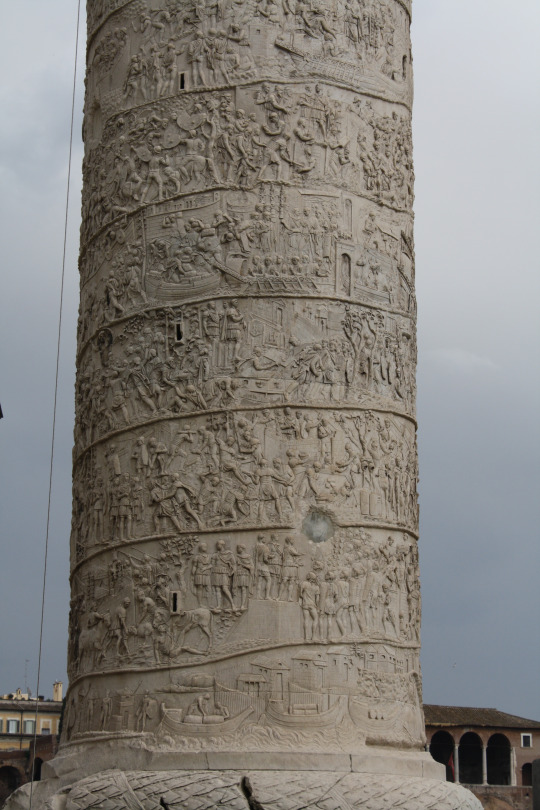
Upclose Photo of Trajan's Column inscriptions.
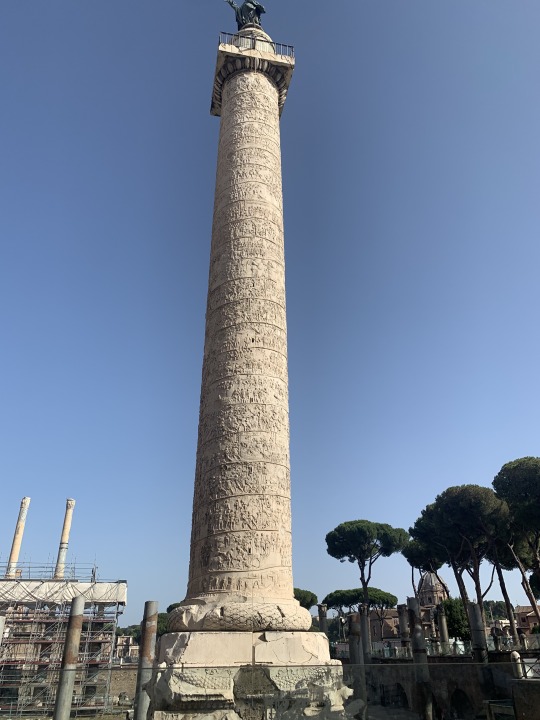
My Photo from afar.
Interpretation through art and tangible and intangible things is a universal concept that allows individuals to relate to what they are interpreting (Beck et al, 2018). We can relate to certain artwork because we know what rocks feel like or the sound of waves, and in turn, these ultimately help encourage emotions and feelings from the intangibles present in the artwork. There are so many hidden meanings in artwork and each individual has the freedom to interpret it in a way that is uniquely their own. I find a sense of peace and blissfulness knowing that nature interpretation through art can facilitate messages throughout our bodies and the fact that this experience is different for everyone. The message being conveyed can impact each individual diversely. It truly can be an eye-opening experience and a way in which we can learn and bond with each other.
Becker., J.A (n.d). Khan Academy. https://www.khanacademy.org/humanities/ancient-art-civilizations/roman/early-empire/a/column-of-trajan#:~:text=The%20column%20itself%20is%20made,weighing%20a%20total%20of%20c.
Beck, L., Cable, T. T., & Knudson, D. M. (2018). Interpreting Cultural and Natural Heritage for a Better World. Sagamore Publishing.
Cartwright, M. (2013, June 09). Detail, Trajan's Column. World History Encyclopedia. Retrieved from https://www.worldhistory.org/image/1271/detail-trajans-column/
4 notes
·
View notes
Text
The Art of Nature
As we all know by now, there are many roles of a nature interpreter, each one crucial in understanding the natural world around us. However, I believe one of the most important aspects of this is being able to appreciate the beauty of the natural world. Appreciating the beauty behind nature is something we universally share, even though these experiences can vary greatly from one another. We can all agree that something is beautiful, however, the way this beauty resonates is unique and personal, an intriguing phenomenon (Beck et al., 2018). For example, a picture or photograph of a mountain landscape can evoke happy emotions in one person, perhaps reminding them of a fond memory, while eliciting a more profound and introspective reaction in another. These reactions can also go beyond memories and experiences and be linked to an individual's culture or religion. Since there is so much variation, I believe it is very important to share our thoughts and experiences when interpreting art as it can provide new insights and perspectives that many have not yet considered. After all, everyone's life experiences impact the way they react and interpret the art around us.
I've mentioned this before in previous blog posts, however, my uncle taught me everything I know about nature. He gave me books that allowed me to appreciate the complexities of nature, while also appreciating the art. Specifically, I remember my sister and I would spend hours looking through books about plants and we would pick out our favorite ones based on their visual appeal. I still remember seeing a bat flower for the first time and finding it fascinating while my sister was a little freaked out. It's interesting to look back now and see how our perceptions of this flower were completely different based on how we perceived it through its artwork.
Throughout my whole life, I have always been interested in painting and drawing, often taking inspiration from nature landscapes. In more recent years I have also taken up nature photography. Whenever I go out to the arboretum with my camera or my sketchpad, I always feel at peace and more in touch with the world around me. In a way, it allows me to communicate with nature directly, which has helped me to develop a more profound love for the environment. Therefore when I think of ‘the gift of beauty’ my mind immediately goes to these experiences. Having the ability to creatively express my thoughts and feelings through art allows me to appreciate nature beyond just aesthetic appeal. It has also become quite therapeutic in a way, allowing me to express my thoughts and emotions. I always show my family and friends my work and I feel as though they are seeing nature through a different lens. Reflecting on it now, I guess you could say one of my roles as a nature interpreter is presenting new perspectives to others. Whether that be because I focused my drawing on a specific plant or animal, it generates thought and insightfulness in others and that's beautiful in itself.
Beck, L., Cable, T. T., & Knudson, D. M. (2018). Chapter 5: Guiding Principles of Interpretation. In Interpreting cultural and natural heritage: For A Better World (pp. 81–103). Sagamore Venture.
0 notes
Text
Hey Chloe,
I enjoyed reading your blog post! I really liked the weightless backpack analogy you touched upon. I think it perfectly describes privilege in a way that could be better understood. Your post was really well written especially how you laid out certain scenarios as it was really easy to put myself in those positions. My house here in Guelph actually backs onto a large forest so a lot of what you described is actually my reality, which I know is not the case for many people including yourself. When I was younger I didn't recognize that this was a privilege I had but as I got older, especially recently, I have learned to greatly appreciate my connection with nature and recognize my place.
I also really liked your point about interpreting nature not being a solo exploration. This is extremely important to understand as our peers have such a great impact on how we live our lives. I know that for me, my uncle who is heavily involved with nature and environmental science taught me most of the things I know today in regards to nature, and not only that but also how to care for and appreciate all aspects of nature. If it wasn't for him influencing my outlook on nature, I'm not sure if I would be in this course right now, which is crazy to think about!
One question I have that I think would be interesting to look at is how the intersectionality of these different privileges such as cultural significance and educational attainment can shape an individual's view on nature interpretation. We know that there can be various aspects of privilege affecting an individual at a single time, so it would be interesting to hear your thoughts on this! Not only that but I would love to hear your thoughts on more practical steps we can take to help those who may have less privilege interact with nature!
Overall really informative post!
The Invisible Backpack: The Impact of Privilege on Nature Interpretation
Welcome to all my fellow lovers of nature!
In this blog post, we take a thoughtful look at the complex and sometimes disregarded idea of privilege in the context of nature interpretation. Let's first create a working definition of privilege before delving into this complex network. In this sense, privilege describes the unjustified advantages and chances that some people or groups enjoy, which are frequently conferred upon them by social structures. Drawing from the perspective of Peggy McIntosh, privilege might be thought of as an unseen, weightless backpack of undeserved assets that people carry around, influencing their experiences. Even though I am white, middle-class, highly educated, speak English, and have a Canadian passport—qualities that are sometimes linked to privilege—there are parts of my relationship with nature where privilege may not be as evident. Let's now explore how privilege shapes our perceptions of the natural world.
Imagine a forest with the scent of earth filling the air, sunlight piercing through the foliage. Imagine this haven being right outside your home, a permanent companion to grow up alongside. Some people consider this situation to be a reality, considering it a benefit of growing up in rural settings with easy access to the outdoors. Reaching these natural havens might be an uncommon and difficult task for people living in busy urban environments, like myself. The way that access varies from person to person highlights how privilege shapes our experiences by acting as a canvas on which we paint our interpretations of nature.
Interpreting nature involves more than just solo exploration; it is also shaped by the mentors and guides we come across. Being in the company of someone who instills a love of the natural world is a blessing that goes beyond brief encounters. In addition to providing access to the marvels of nature, this mentorship instills principles of gratitude and respect. Imagine having a guide who fosters a respectful and sustainable relationship with nature in addition to teaching you about ecosystems. This advice, which influences our perceptions and relationships with the environment, is a privilege that is not always bestowed.
Privilege can manifest itself in a variety of ways, including educational attainment, geographic location, cultural identification, financial standing, time availability, and accessibility. Recognizing and comprehending these intricacies helps us to better grasp the complex viewpoints that influence how we interact with the natural world. Our cultural identities provide distinctive stories, and educational backgrounds improve our comprehension of scientific events. Acknowledging our privileges enables us to view nature interpretation from a more inclusive and compassionate perspective. It provides a forum for a variety of discussions that deepen our understanding of nature as a group.
Remember our invisible backpacks as we explore the broad regions of nature interpretation. In all of its manifestations, privilege gives our experiences depth and shapes the narratives and viewpoints we exchange. Let's explore the wonders of nature with open minds and hearts, ready to welcome the many perspectives that add to our common understanding of the natural world.
Through deliberate examination and acknowledgement of our privilege, we may work together to create a more inclusive narrative of nature.
Until next time! :)
4 notes
·
View notes
Text
Privilege in Nature
Within almost every aspect of life, some form of privilege exists. Privilege in general refers to the overall advantages and/or benefits that certain individuals or groups have. In terms of nature interpretation, privilege can present itself in many ways through how people interact, perceive, and experience nature. Many factors can influence this idea of privilege, whether that be socio-economic class, education, and culture to name a few.
I find that when privilege is typically present, the individuals who experience this privilege do not know it, or often take it for granted. For example, I have grown up in Guelph most of my life, and have close family that live in beautiful rural farm areas. Having this in my life made me privileged as I have always been able to access and interact with nature, no matter where I was. Guelph is home to many nice trails, streams, and lakes which I never really took the time to appreciate until recently. One of my favourite activities to do now in the summer is go for long walks along Guelph Lake and watch the amazing sunsets with my friends and family. I recognize now that I am very privileged to live in an area where I can experience and appreciate nature not only by myself but also with those close to me, as many individuals who live in other areas do not have this. Therefore I believe that one of the more evident forms of privilege is presented through accessibility. Many people don't even recognize the privilege they have when they are located close to nature.
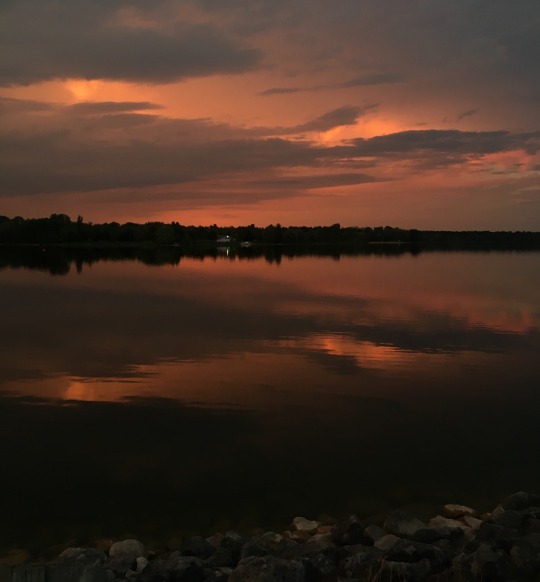
A picture I took last summer at Guelph Lake
As mentioned earlier socioeconomic class can also have a large impact on privilege in the natural world. Those who do not possess the financial means to travel to places and experience different natural wonders, purchase equipment suited for the outdoors or even partake in more community-based activities like nature walks are at a disadvantage and their connection with nature is negatively impacted.
Economic privilege can also play a role in educational privilege. Some individuals may not be able to afford educational programs that teach them about nature and conservation efforts. Individuals with access to quality education will often develop a much deeper understanding of not only nature as a whole but also the various intricate aspects of nature, such as biodiversity, ecological systems, and various environmental issues. By having this education it generates a sense of responsibility in these individuals and often increases their advocacy on this subject. Those without these educational means may not fully understand or care about such conservation efforts.
Privilege can also present itself in different cultures. Throughout history, nature has played important roles in certain cultures, such as the indigenous community, in which they have a deep respect and sense of belonging within nature. Individuals who grew up in more urbanized areas will have less of a connection with nature. This cultural divide can make it difficult for people in more urban areas to fully understand the significance nature serves within culturally privileged individuals. They may not be able to understand and interpret the depth of the natural world and the significance it presents for others in a different culture.
Overall, it is evident that privilege is present in various aspects of life. It is important to understand that having these privileges is not a bad thing, however, it is our duty as privileged individuals to recognize the privilege we possess and not take it for granted (Beck et al., 2018). We must recognize our roles and help others to connect with nature as well. One way in which we could do so is to make more free/accessible community-based nature activities and programs, ensuring everyone has the opportunity to connect and experience their own natural world!
Beck, L., Cable, T. T., & Knudson, D. M. (2018). Chapter 7: Serving Diverse Audiences. In Interpreting cultural and natural heritage: For A Better World (pp. 127–158). Sagamore Venture.
0 notes
Text
I really enjoyed your blog post! Almost every summer my family and I go camping in a provincial park similar to you, however, you have gone to so many places I'm jealous! I too love to explore different landscapes. My favourite thing to do while camping is to explore long trails and hikes where I can just take in my surroundings. I have always wanted to go and see Nova Scotia and the photo you included definitely furthered that. It looks so beautiful! I relate a lot with your post as I also explored a similar role within a provincial park in Canada as a nature interpreter. I loved all the little details you touched upon such as nature journaling and the games to play with the kids. It really shows that you care about how you would teach and educate people. In terms of skills, you touched upon quite a few that I didn't even think of when writing my post, but really got me thinking. GPS is definitely a very important skill to have especially if you are leading walks in the forest. I like how you went into quite a bit of detail in terms of teaching and communicating with different people. You addressed utilizing the Cognitive Development Theory to better tailor the information being presented to different age groups. After reading this point it got me wondering how one might go about doing that in terms of nature interpretation as I think it's a great idea!
Overall great post!
My Dream Role as an Environmental Interpreter
Growing up, I loved opportunities to go on camping trips to various provincial parks in Ontario. I remember visiting Balsam Lake, Sibbald Point, Six Mile Lake, Killbear and Wasaga Beach Provincial Park. I loved exploring these natural areas and discovering new landscapes and environments within Ontario.

A picture I took at Cape Breton Highlands National Park in Nova Scotia.
My ideal role as an environmental interpreter would be as a park interpreter at a provincial or national park within Canada. My role as park interpreter would involve assisting visitors to explore park trails and swimming areas while providing informational programs safely and respectfully. I would love to run programs such as nature journaling, biodiversity hikes or games such as Wolf Prowl which allows kids to take on roles as animals in an ecosystem. I would also like to help run evening programs that permit visitors to safely explore the trails in the dark which they might not do on their own. As a park interpreter, I would like to focus some programs on establishing people's relationships with nature and sustainability.
The job of an environmental interpreter would require a variety of skills to deliver effective and meaningful interpretation. The skills I first thought of included plant and animal identification and knowledge of ecology, geology, and environmental stewardship. Additional skills in mapping, GPS, and first aid would also be crucial in a role as a park interpreter. Skills in these areas will allow me to be a reliable source of information that visitors can trust with their questions regarding the natural heritage of conservation areas. These areas of knowledge and skills I have listed are essential for environmental interpretation, however, I do not think they are the most important.
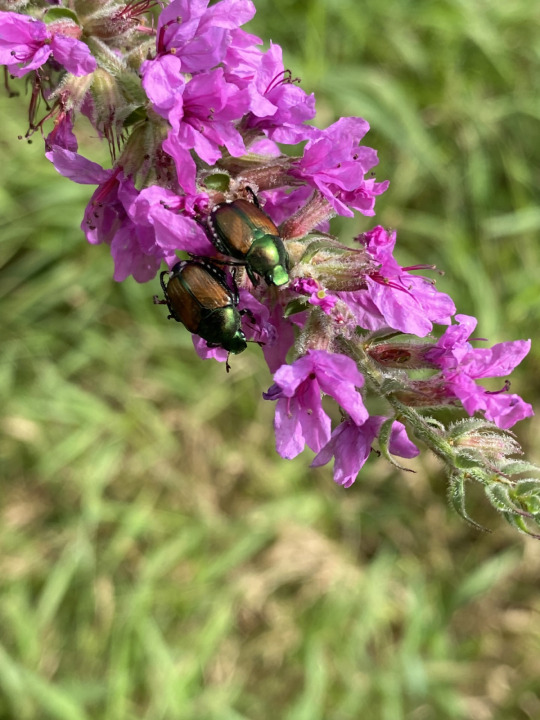
A picture I took of a Japanese beetle (Popillia japonica) on a hike on the Brook Trail in Uxbridge.
Before having the opportunity to work in outdoor education and to read the textbook, Interpreting Cultural and Natural Heritage: For A Better World, I thought knowledge of the environment would be the most important skill to have as an interpreter. However, you could have all the knowledge of nature possible but if you cannot communicate with individuals then you will not be able to effectively share the beauty of nature with others. As described by Beck et al. (2019), communication is the core of cultural and natural interpretation.
In an environmental interpreter role, I would need to be skilled in applying different learning theories and styles to communicate natural surroundings to a diverse group of people. Having the ability to use the Cognitive Development Theory through numerous interpretation forums will allow me to interact with different age groups (Beck et al., 2019). Also, having skills working with multiple intelligences will allow me to connect with a variety of people who learn in different ways (Beck et al., 2019).

A photograph I took in British Columbia at a Natural heritage site.
As an outdoor education intern, I saw many kids with different interests and ways of learning. Some kids connected better to lessons involving games such as Predator-Prey where they got to run around but still learnt about ecosystem functions. Other kids preferred to explore ecosystems through nature journaling or nature photography programs. All kids were able to leave the outdoor education center with new knowledge and new feelings toward the environment through different pathways.
By utilizing my knowledge of the environment with communication and teaching skills I could succeed as an interpreter at a natural heritage site such as provincial or national parks. Communicating my understanding of different environments and sharing my passion for nature would allow me to guide people to form their own connections and ideas of nature.
References
Beck, L., Cable, T. T., & Knudson, D. M. (2019). Interpreting cultural and natural heritage: For A Better World. Sagamore Publishing.
7 notes
·
View notes
Text
Roles of a Nature Interpreter
This week's blog prompt got me thinking, specifically about my interests and how I can incorporate this into communicating information regarding the natural environment to the public. I touched upon it briefly in my last blog post, however, I have always really enjoyed photography, and in recent years nature photography has become a hobby of mine.
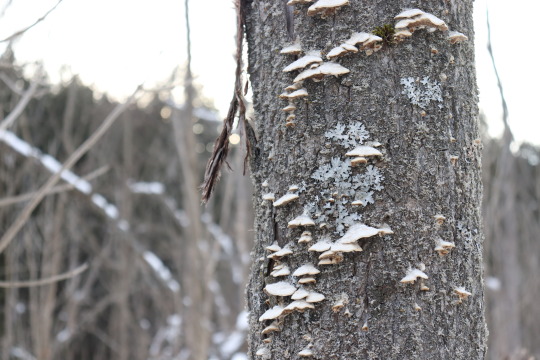
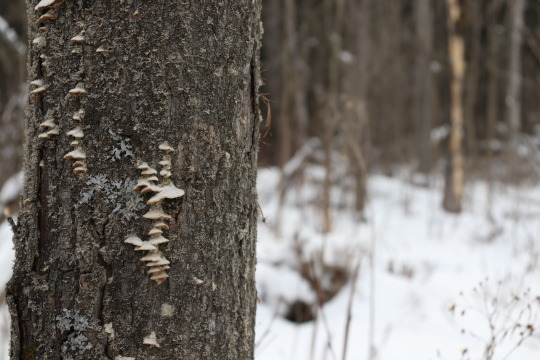
Some photos I took the other day while on a walk :)
In terms of my ideal role as an environmental interpreter, I envision a position in which I can combine my love for the environment and capture it through a lens. I also love to find new trails and hikes in which I can explore nature, so it would also be nice to incorporate this into my role. Therefore, I envision myself working as some type of park guide in which I can share all my knowledge with others and demonstrate the beauty and importance of nature through real-world experiences as well as photographs. I would love to focus on birds, their importance, and their impact on our environment. I have always had an interest in birds and believe that they are beautiful animals! One specific location that I've always been interested in is Banff National Park. Banff is home to over 311 species of birds with the Grey Jay or Canada Jay being one of the most popular, which is one of my favourite birds. I have previously done projects on these birds so it would be cool to explore even more in-depth about them and hopefully teach other people everything I love about them as well! In this role, my responsibilities would include giving guided tours outlining the importance of different plant and animal species, with a focus on birds, and creating a fun environment in which children and adults of all ages want to learn. I believe it would be fun to focus more on the visual aspect of nature interpretation, teaching people how to identify differences between certain plant species and so on. This would help to tie in my love for photography! I would also love to include as many hands-on activities and experiences for them as I believe this helps to immerse people in their environmental surroundings. I am a more hands-on learner however, as a nature interpreter, I must recognize the various learning styles and cater my teaching to address everyone's needs.
Another way in which I could envision myself taking on the nature interpreter role would be through an online blog or website which would act as a virtual gateway into the natural world. I would love to showcase my photographs alongside insights and personal stories to help educate and enlighten individuals about the amazing world around us! Each post will address various ecosystems, the intricacies of wildlife, and how/why environmental conservation is extremely important in today's day and age. No matter what roles I would take on as an environmental interpreter, I just want to make a difference and show people that caring about nature is super important, just as people have taught me!
11 notes
·
View notes